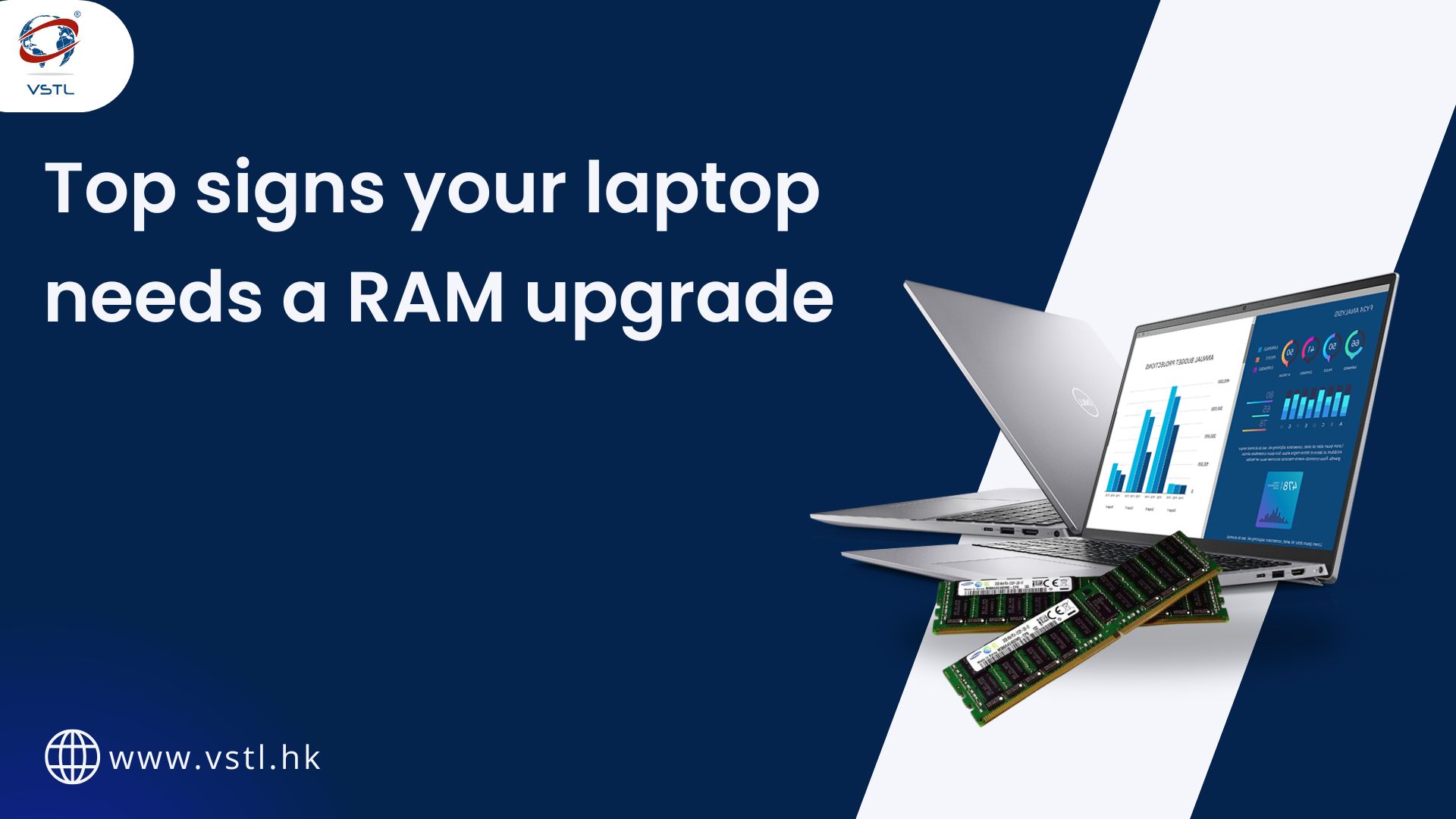
In today’s digital age, a laptop is more than just a device—it’s a necessity for work, study, entertainment, and more. However, over time, even the best laptops can start to show signs of slowing down. One of the most common reasons? Insufficient RAM.
RAM (Random Access Memory) is crucial for your laptop’s performance. It allows your system to run multiple applications smoothly and handle demanding tasks. If your laptop doesn’t have enough RAM, it can lead to frustrating lags, crashes, and reduced efficiency.
How can you tell if your laptop’s RAM needs an upgrade? Let’s break it down into simple, clear signs.
1. Slow Performance During Everyday Tasks
One of the most obvious signs that your laptop needs more RAM is slow performance during regular tasks. If you notice that opening web browsers, editing documents, or switching between applications takes longer than usual, your system might be running out of available memory.
For example:
- Websites with lots of images or videos take ages to load.
- Typing in documents feels delayed or sluggish.
- Opening simple programs like a calculator or photo viewer is unusually slow.
This sluggish behavior indicates your laptop’s RAM is struggling to keep up with your needs.
2. Frequent Freezing or Crashing
Does your laptop freeze or crash unexpectedly? This could be another sign of insufficient RAM. When your system runs out of memory, it struggles to allocate resources to applications, leading to crashes.
Here’s when it’s most noticeable:
- Your browser freezes when you have multiple tabs open.
- Applications stop responding, forcing you to restart them.
- Your laptop crashes when running multiple programs at once.
Such incidents are frustrating and disrupt productivity.
3. Multitasking Becomes Impossible
Multitasking is a part of daily life. You might have a browser open for research, a video call running, and a document editor open—all at the same time. If your laptop struggles to handle this, it’s likely because your RAM isn’t sufficient.
Signs of multitasking issues include:
- Switching between applications takes a long time.
- Programs close unexpectedly when you open new ones.
- You notice significant lag when performing simple tasks.
Upgrading your RAM can bring back the smooth multitasking experience you’re used to.
4. Programs Take Too Long to Load
If you find yourself staring at loading screens longer than usual, your laptop’s RAM may be the culprit. Programs like video editors, graphic design tools, or even games require a significant amount of memory to run efficiently.
For instance:
- Photoshop or video editing software struggles to load or render files.
- Games take forever to start and lag during gameplay.
- Even lightweight programs feel heavy and unresponsive.
A RAM upgrade can make these programs load faster and run smoothly.
5. High Memory Usage in Task Manager
Your laptop’s Task Manager is an excellent tool for checking memory usage. If you frequently see your RAM usage nearing 100%, it’s a clear indication that you need more memory.
To check memory usage:
- Press Ctrl + Shift + Esc to open Task Manager.
- Go to the Performance tab and click on Memory.
- Look at the percentage of memory in use.
If it’s consistently high, your laptop is crying out for a RAM upgrade.
6. Low Frame Rates During Gaming
For gamers, low frame rates and stuttering during gameplay are telltale signs of insufficient RAM. Modern games require a lot of memory to handle textures, assets, and real-time rendering.
Here’s what to look out for:
- The game lags, even on lower graphics settings.
- Movement and animations feel choppy.
- Long loading times before or during gameplay.
Adding more RAM can transform your gaming experience, making it smoother and more enjoyable.
7. Delays During Video Editing or Rendering
Video editing is one of the most RAM-intensive tasks. If you’re experiencing delays, crashes, or poor performance while editing or rendering videos, your laptop’s RAM might not be sufficient.
Common problems include:
- Timeline scrubbing feels slow and unresponsive.
- Exporting videos takes much longer than expected.
- Your system becomes unresponsive during rendering.
Upgrading RAM allows your laptop to handle larger files and complex editing tasks effortlessly.
8. Browser Tabs Keep Reloading
Do you keep multiple browser tabs open? If your laptop keeps reloading tabs or closes them unexpectedly, it’s a sign your RAM can’t keep up.
For example:
- You switch to a different tab, and the previous one reloads when you return.
- Websites crash when you open too many tabs.
- Your browser warns you about low memory.
A RAM upgrade will make web browsing seamless, even with dozens of tabs open.
9. System Struggles After a Software Update
Software updates often bring new features and improvements, but they can also increase memory requirements. If your laptop feels slower after installing updates, your RAM may not meet the new demands.
Examples include:
- The operating system takes longer to boot up.
- Applications that worked fine before now lag or freeze.
- You notice a general slowdown in performance.
Adding more RAM ensures your system remains future-proof against updates.
10. Virtual Machines Perform Poorly
If you use virtual machines (VMs) for testing or development, poor performance is a clear sign of insufficient RAM. VMs require a large amount of memory to simulate separate operating systems.
Symptoms include:
- VMs are slow to boot.
- Running multiple VMs causes your laptop to freeze.
- Applications inside the VM lag significantly.
More RAM can drastically improve the performance of virtual environments.
11. Disk Usage Spikes Frequently
When your laptop runs out of RAM, it uses the hard drive or SSD as virtual memory, which is much slower. This leads to high disk usage and slower overall performance.
Check for these signs:
- Your laptop’s fan becomes noisy as the system struggles.
- Disk usage stays at 100% in Task Manager.
- Applications slow down during intense tasks.
Adding more RAM reduces the need for virtual memory, enhancing performance.
12. Poor Performance in Creative Applications
Creative professionals using tools like Adobe Premiere, After Effects, or 3D modeling software often face issues due to limited RAM. These applications demand high memory for smooth operation.
Look out for:
- Long rendering times.
- Frequent crashes during complex projects.
- Delays in applying effects or filters.
A RAM upgrade can significantly improve your workflow, making these applications faster and more reliable.
How to Upgrade Your Laptop’s RAM
If you’ve identified any of the above signs, it’s time to consider a RAM upgrade. Here’s a simple guide:
- Check Compatibility: Identify the type of RAM your laptop uses (DDR3, DDR4, or DDR5) and its maximum supported capacity.
- Buy the Right RAM: Purchase RAM from a trusted brand that matches your laptop’s specifications.
- Install the RAM: Most laptops have easy-access panels for upgrading RAM. Follow the manufacturer’s guide or seek professional help.
- Test Your System: After installation, check if your laptop runs faster and handles tasks more efficiently.
Conclusion
Upgrading your laptop’s RAM is one of the easiest and most cost-effective ways to boost performance. Whether you’re a gamer, professional, or casual user, ensuring your laptop has enough memory can make all the difference.
If you’ve noticed slowdowns, crashes, or any of the other signs mentioned above, don’t wait! Upgrade your RAM and enjoy a faster, smoother laptop experience.
